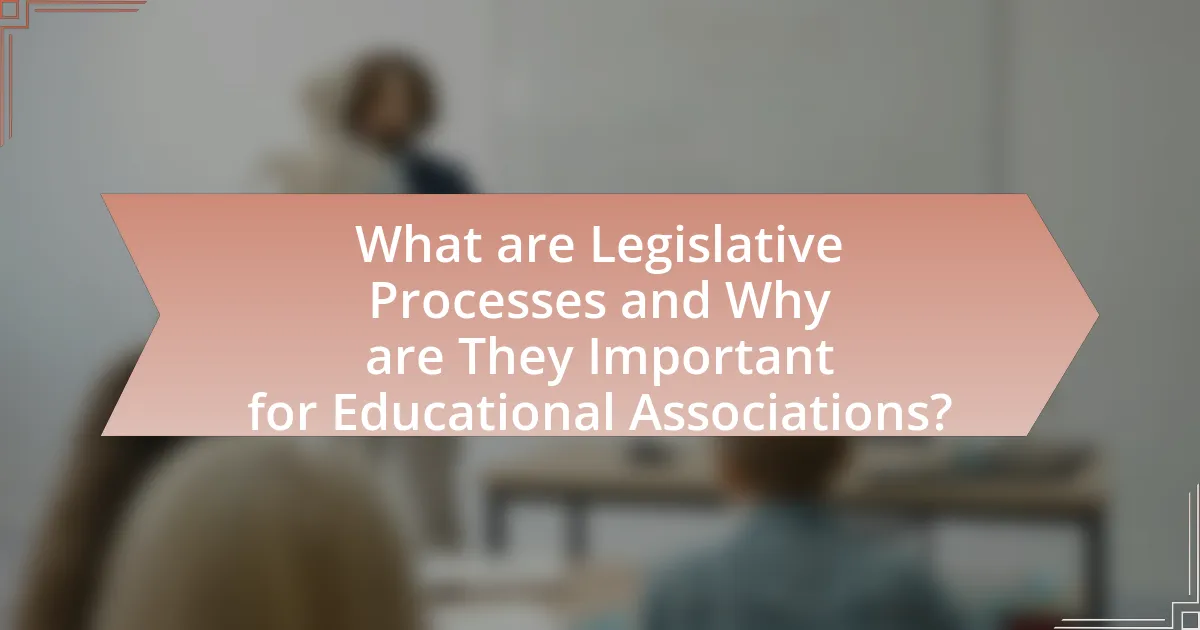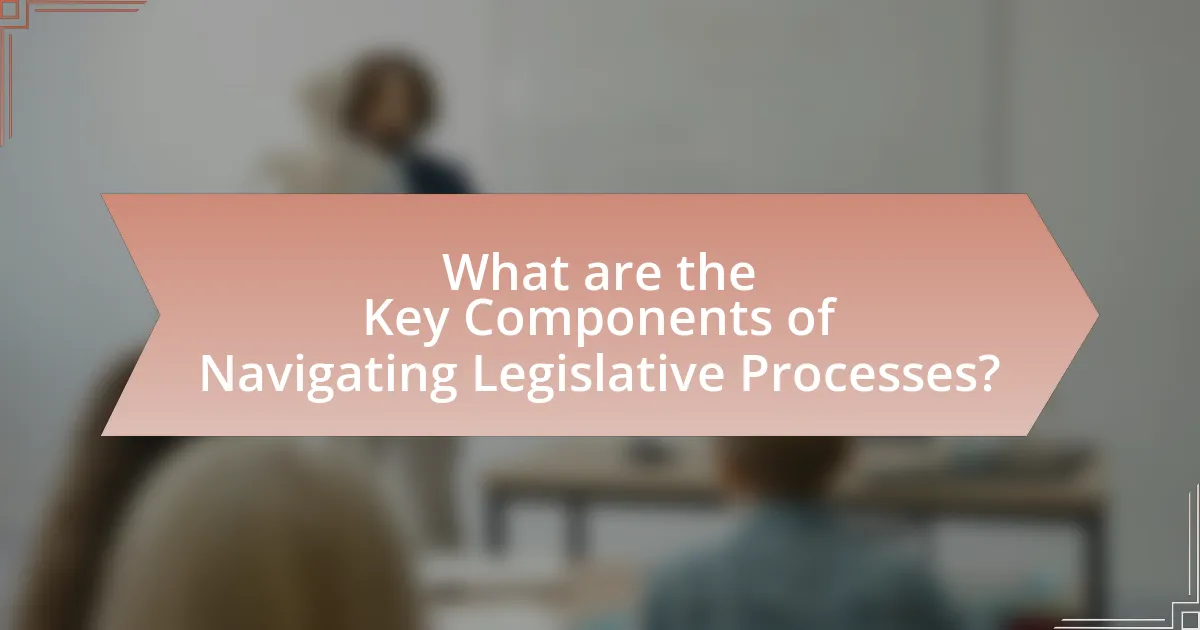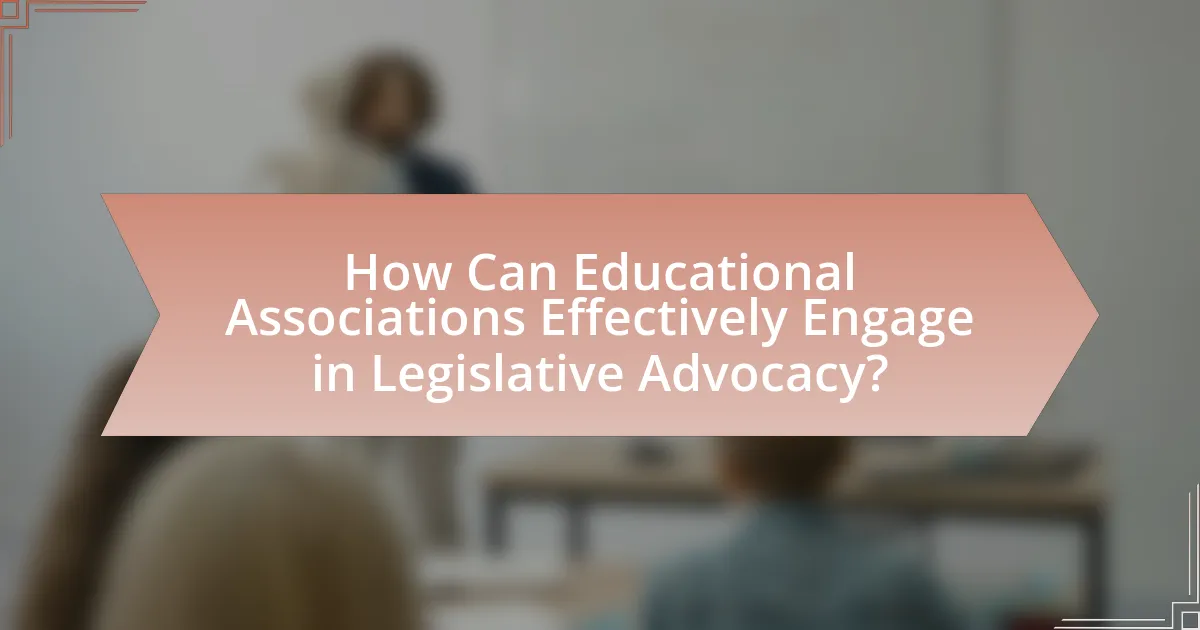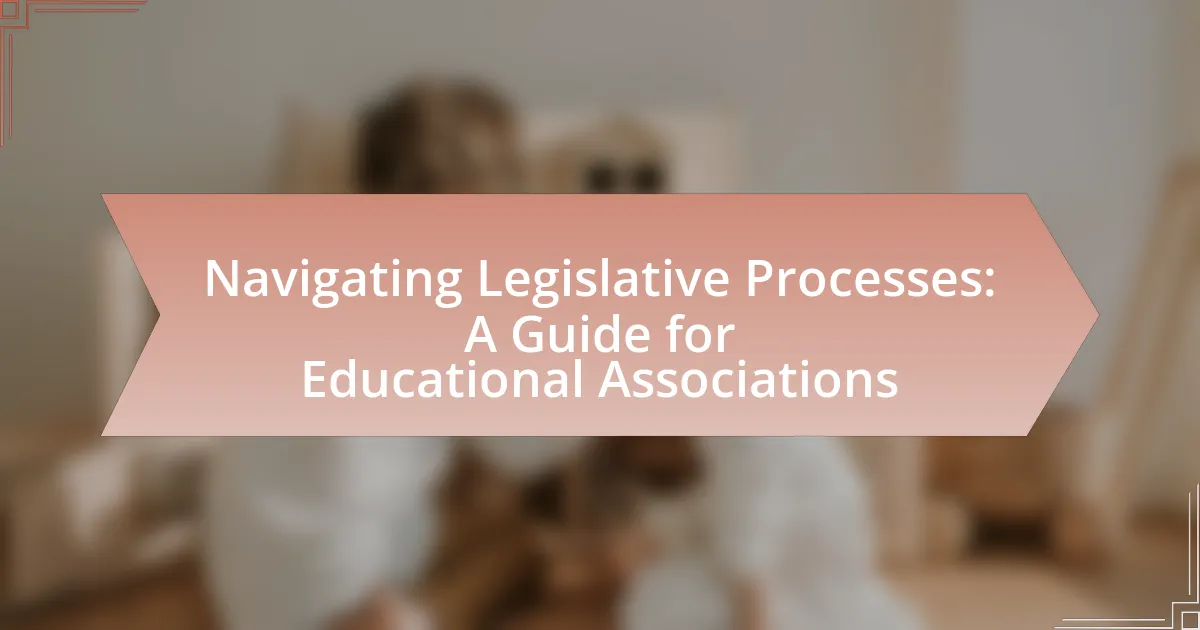The article focuses on the legislative processes that educational associations must navigate to influence policy decisions affecting education. It outlines the significance of these processes in shaping educational policies, funding allocations, and regulatory frameworks. Key stages of the legislative process, such as introduction, committee review, and voting, are detailed, along with the roles educational associations play in advocacy efforts. The article also discusses strategies for effective engagement with legislators, common challenges faced by associations, and best practices for successful legislative navigation, emphasizing the importance of collaboration and data-driven advocacy.

What are Legislative Processes and Why are They Important for Educational Associations?
Legislative processes are the formal procedures through which laws are proposed, debated, and enacted by governmental bodies. These processes are crucial for educational associations because they enable these organizations to influence policy decisions that affect education systems, funding, and regulations. For instance, educational associations can advocate for legislation that supports teacher training, curriculum development, and equitable funding, thereby directly impacting the quality of education. By participating in legislative processes, educational associations ensure that their members’ voices are heard and that their interests are represented in the policymaking arena.
How do legislative processes impact educational policies?
Legislative processes significantly impact educational policies by determining the allocation of funding, setting regulatory frameworks, and establishing standards for educational institutions. For instance, legislation such as the Every Student Succeeds Act (ESSA) directly influences how states develop their educational systems, including accountability measures and assessment requirements. Additionally, legislative decisions regarding budget appropriations can affect resources available for schools, impacting class sizes, teacher salaries, and educational programs. Historical data shows that changes in federal education funding can lead to shifts in state-level educational priorities, demonstrating the direct correlation between legislative actions and educational policy outcomes.
What are the key stages of the legislative process?
The key stages of the legislative process are introduction, committee review, floor debate, voting, and presidential approval. During the introduction stage, a bill is proposed in either the House of Representatives or the Senate. The committee review stage involves detailed examination and possible amendments by a committee. Following this, the floor debate stage allows for discussion among all members before the bill is voted on. If passed, the bill is sent to the president for approval or veto. This process is essential for transforming proposed legislation into law, ensuring thorough scrutiny and debate at multiple levels of government.
How do these stages affect educational associations?
The stages of legislative processes significantly affect educational associations by determining their ability to influence policy outcomes. Educational associations engage in advocacy during these stages, which include agenda-setting, formulation, adoption, implementation, and evaluation. For instance, during the agenda-setting stage, educational associations can highlight critical issues affecting education, thereby shaping the legislative priorities of policymakers. Research shows that associations that actively participate in these stages can secure funding and support for educational initiatives, as evidenced by the National Education Association’s successful lobbying for increased federal education funding in 2020. Thus, the effectiveness of educational associations in navigating these stages directly correlates with their impact on educational policy and resource allocation.
What roles do educational associations play in legislative processes?
Educational associations play a crucial role in legislative processes by advocating for policies that benefit the education sector. These associations represent the interests of educators, administrators, and students, providing a collective voice in discussions with lawmakers. They engage in lobbying efforts to influence legislation, often presenting research and data to support their positions. For instance, the National Education Association (NEA) actively campaigns for funding increases in public education, demonstrating the impact of their advocacy through statistics on student performance and resource allocation. Additionally, educational associations often facilitate communication between their members and legislators, ensuring that the perspectives of educators are considered in policy-making.
How can educational associations influence policy decisions?
Educational associations can influence policy decisions by advocating for specific educational reforms and providing expert insights to policymakers. These associations often engage in lobbying efforts, where they present research, data, and case studies that highlight the benefits of proposed policies. For instance, the National Education Association (NEA) has successfully influenced legislation by mobilizing its members to contact lawmakers, thereby demonstrating the collective voice of educators. Additionally, educational associations often collaborate with government agencies to develop policy frameworks, ensuring that the perspectives of educators are integrated into decision-making processes. This collaborative approach is supported by evidence showing that policies informed by educational professionals tend to be more effective and relevant to the needs of schools and students.
What strategies can associations use to engage with legislators?
Associations can engage with legislators through direct advocacy, grassroots mobilization, and strategic partnerships. Direct advocacy involves organizing meetings with legislators to discuss specific issues and present data that supports the association’s position, which can influence legislative decisions. Grassroots mobilization encourages members to contact their representatives, amplifying the association’s voice and demonstrating widespread support for particular policies. Strategic partnerships with other organizations can enhance credibility and broaden the impact of advocacy efforts, as seen in coalitions that successfully lobbied for educational reforms. These strategies are effective as they create a structured approach to influence policy-making and ensure that the concerns of the association’s members are represented in legislative discussions.

What are the Key Components of Navigating Legislative Processes?
The key components of navigating legislative processes include understanding the legislative framework, engaging with stakeholders, and utilizing effective communication strategies. The legislative framework outlines the rules and procedures governing the creation and modification of laws, which is essential for educational associations to comprehend in order to influence policy effectively. Engaging with stakeholders, such as legislators, advocacy groups, and the community, allows associations to build coalitions and gather support for their initiatives. Effective communication strategies, including clear messaging and targeted outreach, are crucial for conveying the association’s positions and mobilizing support. These components are validated by the necessity for educational associations to adapt to the dynamic political landscape and advocate for policies that benefit their members and the broader educational community.
What resources are available for educational associations to understand legislative processes?
Educational associations can utilize various resources to understand legislative processes, including government websites, advocacy organizations, and educational policy research centers. Government websites, such as those of the U.S. Congress and state legislatures, provide official information on legislative procedures, bills, and committee activities. Advocacy organizations like the National Education Association offer guides and training on navigating legislative advocacy. Additionally, educational policy research centers, such as the Institute for Educational Leadership, publish reports and analyses that clarify legislative impacts on education. These resources collectively enhance the understanding of legislative processes for educational associations.
How can associations access legislative tracking tools?
Associations can access legislative tracking tools by subscribing to specialized services that provide real-time updates on legislative activities. These services, such as CQ Roll Call, GovTrack, and LegiScan, offer comprehensive databases and tracking capabilities that allow associations to monitor bills, legislative sessions, and committee activities relevant to their interests. Many of these platforms also provide customizable alerts and reports, ensuring that associations receive timely information tailored to their specific needs.
What training opportunities exist for association members?
Training opportunities for association members include workshops, webinars, and certification programs focused on legislative processes relevant to educational associations. These training sessions are designed to enhance members’ understanding of policy-making, advocacy strategies, and effective communication with legislators. For instance, many associations offer annual conferences that feature expert-led sessions on current legislative issues, providing members with practical skills and knowledge applicable to their roles. Additionally, online resources and training modules are often available, allowing members to access information at their convenience.
What are the common challenges faced by educational associations in legislative advocacy?
Educational associations commonly face challenges in legislative advocacy, including limited resources, lack of political influence, and difficulties in mobilizing members. Limited resources hinder their ability to conduct comprehensive research and outreach, which is essential for effective advocacy. Additionally, many educational associations struggle with a lack of political influence, making it challenging to sway policymakers or gain access to decision-making processes. Mobilizing members for advocacy efforts can also be difficult, as engagement levels may vary, leading to inconsistent support for legislative initiatives. These challenges collectively impede the effectiveness of educational associations in advocating for policies that benefit their constituents.
How can associations overcome these challenges?
Associations can overcome challenges in navigating legislative processes by actively engaging in advocacy efforts and building strong relationships with policymakers. By establishing a clear communication strategy, associations can effectively convey their positions and influence legislative outcomes. For instance, the National Education Association has successfully mobilized its members to advocate for educational reforms, demonstrating the power of collective action in shaping policy. Additionally, providing training and resources to members on legislative processes enhances their ability to participate effectively, as seen in various educational associations that offer workshops and seminars on advocacy skills.
What role does collaboration play in addressing these challenges?
Collaboration plays a crucial role in addressing challenges within legislative processes for educational associations by fostering collective problem-solving and resource sharing. When educational associations collaborate, they can pool their expertise, influence, and networks to advocate more effectively for policy changes. For instance, a study by the National Education Association highlights that collaborative efforts among various educational stakeholders resulted in successful legislative outcomes, such as increased funding for public schools. This demonstrates that collaboration not only enhances the capacity to address complex challenges but also leads to more impactful advocacy efforts.

How Can Educational Associations Effectively Engage in Legislative Advocacy?
Educational associations can effectively engage in legislative advocacy by developing strategic relationships with policymakers and utilizing data-driven approaches to influence education policy. These associations should prioritize building coalitions with other stakeholders, such as parents, teachers, and community organizations, to amplify their voice and create a unified front.
Additionally, they can leverage research and statistics to present compelling arguments that highlight the impact of proposed legislation on educational outcomes. For instance, studies have shown that advocacy efforts backed by solid data can significantly sway legislative decisions, as evidenced by the National Education Association’s successful campaigns that resulted in increased funding for public schools.
By actively participating in public hearings, providing expert testimony, and mobilizing their members to contact legislators, educational associations can ensure that their perspectives are considered in the legislative process.
What best practices should educational associations follow in legislative advocacy?
Educational associations should prioritize building strong relationships with legislators as a best practice in legislative advocacy. Establishing ongoing communication with lawmakers fosters trust and ensures that educational concerns are represented effectively. Additionally, associations should engage in grassroots mobilization, encouraging members to participate in advocacy efforts, which amplifies their voice and influence.
Furthermore, providing clear, data-driven policy recommendations is essential; research shows that legislators are more likely to support initiatives backed by solid evidence. For instance, the National Education Association emphasizes the importance of using statistics and case studies to illustrate the impact of proposed legislation on education.
Lastly, continuous education and training for association members on advocacy strategies enhance their effectiveness in legislative efforts. According to the American Association of Colleges for Teacher Education, informed advocates can better articulate their positions and respond to counterarguments, leading to more successful outcomes in legislative processes.
How can associations build relationships with lawmakers?
Associations can build relationships with lawmakers by engaging in consistent communication and advocacy efforts. This involves organizing meetings, providing lawmakers with relevant information about their issues, and demonstrating how proposed legislation impacts their members. For instance, associations can share data and case studies that highlight the benefits of their initiatives, thereby establishing credibility and fostering trust. Research indicates that personal relationships and regular interactions significantly enhance the likelihood of lawmakers supporting specific policies, as evidenced by the National Association of State Legislatures, which emphasizes the importance of ongoing dialogue between associations and legislators.
What communication strategies are most effective in advocacy efforts?
Effective communication strategies in advocacy efforts include storytelling, data-driven messaging, and building coalitions. Storytelling engages audiences emotionally, making complex issues relatable and memorable. Data-driven messaging provides credible evidence to support claims, enhancing the persuasive power of the advocacy. Building coalitions leverages the strengths and resources of multiple organizations, amplifying the reach and impact of the advocacy message. Research shows that campaigns utilizing these strategies can increase public support and influence policy decisions significantly. For instance, a study by the FrameWorks Institute highlights that narratives can shift public perceptions and policy priorities effectively.
What are the potential pitfalls in legislative advocacy for educational associations?
The potential pitfalls in legislative advocacy for educational associations include lack of clear objectives, insufficient stakeholder engagement, and inadequate understanding of the legislative process. Educational associations often fail to define specific goals, which can lead to ineffective advocacy efforts. Additionally, not involving key stakeholders, such as teachers, parents, and community members, can result in a lack of support and diminished credibility. Furthermore, a poor grasp of legislative procedures and timelines can hinder the ability to influence policy effectively. These pitfalls can ultimately undermine the association’s advocacy efforts and limit their impact on educational policy.
How can associations avoid common mistakes in their advocacy efforts?
Associations can avoid common mistakes in their advocacy efforts by developing a clear strategy that includes defined goals, target audiences, and messaging. A well-structured advocacy plan ensures that associations focus their resources effectively and communicate their objectives clearly to stakeholders. Research indicates that organizations with strategic advocacy plans are 50% more likely to achieve their legislative goals compared to those without such plans. Additionally, regularly evaluating and adapting their strategies based on feedback and changing circumstances helps associations stay relevant and effective in their advocacy efforts.
What lessons can be learned from successful advocacy campaigns?
Successful advocacy campaigns demonstrate the importance of clear messaging and strategic coalition-building. Clear messaging ensures that the campaign’s goals are easily understood by the target audience, which can lead to increased public support and engagement. For instance, the “It’s Time to Care” campaign in the United States effectively communicated the need for healthcare reform, resulting in significant public backing and legislative changes. Strategic coalition-building, as seen in the “March for Our Lives” movement, showcases how uniting diverse groups can amplify voices and create a stronger impact, leading to policy discussions on gun control. These examples illustrate that clarity in communication and collaboration among stakeholders are crucial for the success of advocacy efforts.
What practical tips can educational associations implement for successful legislative navigation?
Educational associations can implement several practical tips for successful legislative navigation, including building strong relationships with lawmakers, staying informed about legislative developments, and engaging members in advocacy efforts. Establishing connections with legislators fosters trust and opens communication channels, which can lead to more effective advocacy. Regularly monitoring legislative updates through reliable sources ensures that associations are aware of relevant bills and policy changes, allowing them to respond promptly. Additionally, involving members in advocacy initiatives, such as grassroots campaigns or lobbying efforts, amplifies the association’s voice and demonstrates collective support for educational issues. These strategies are supported by the National School Boards Association, which emphasizes the importance of proactive engagement in legislative processes for effective advocacy.


